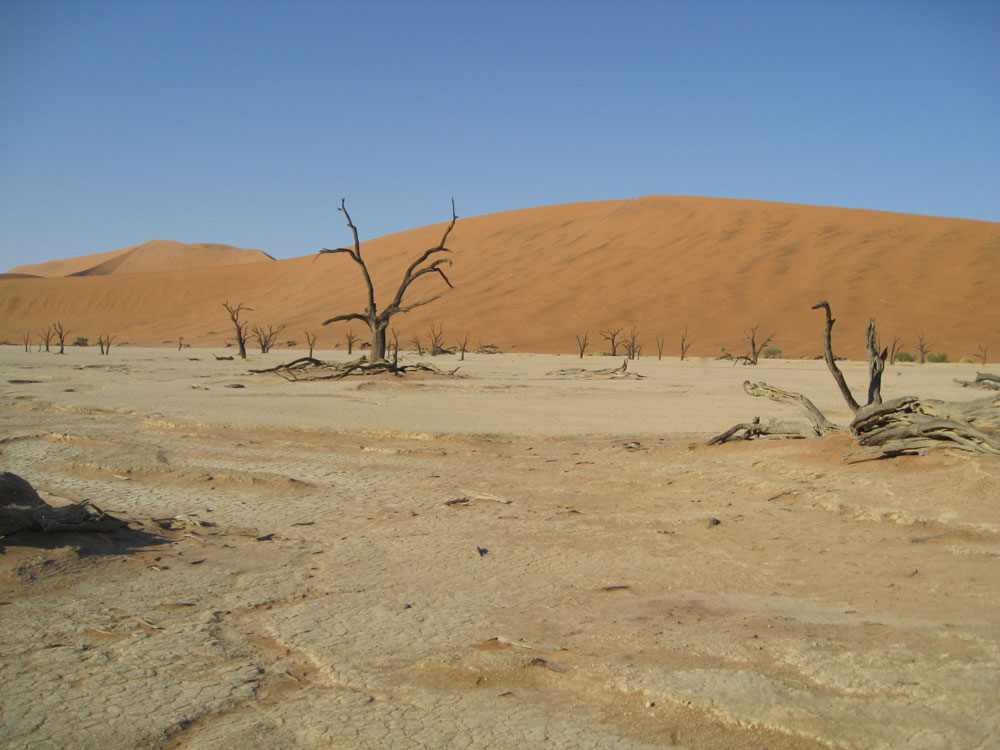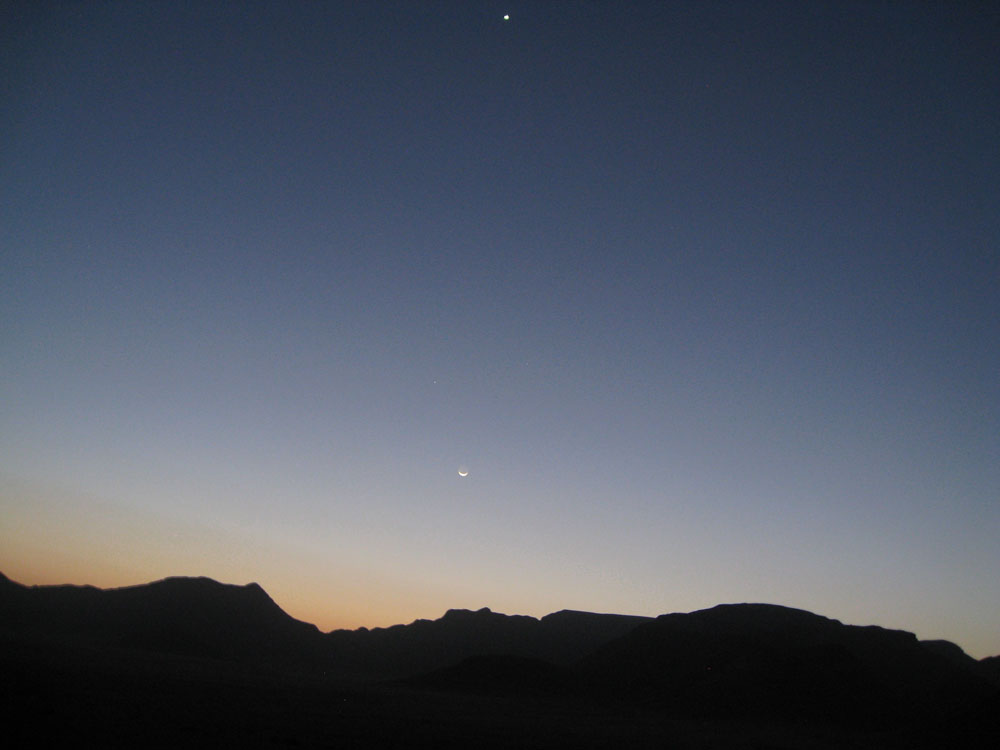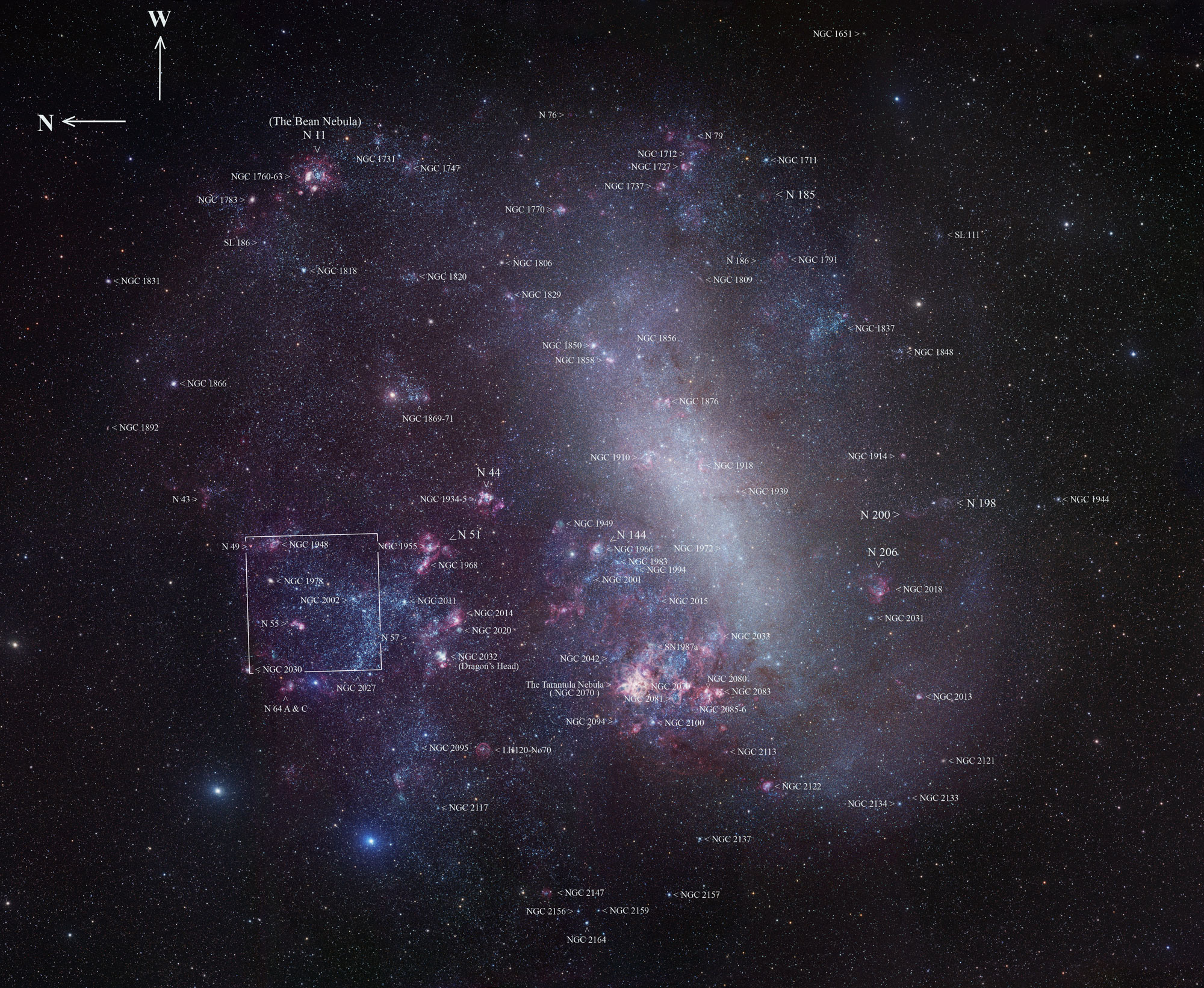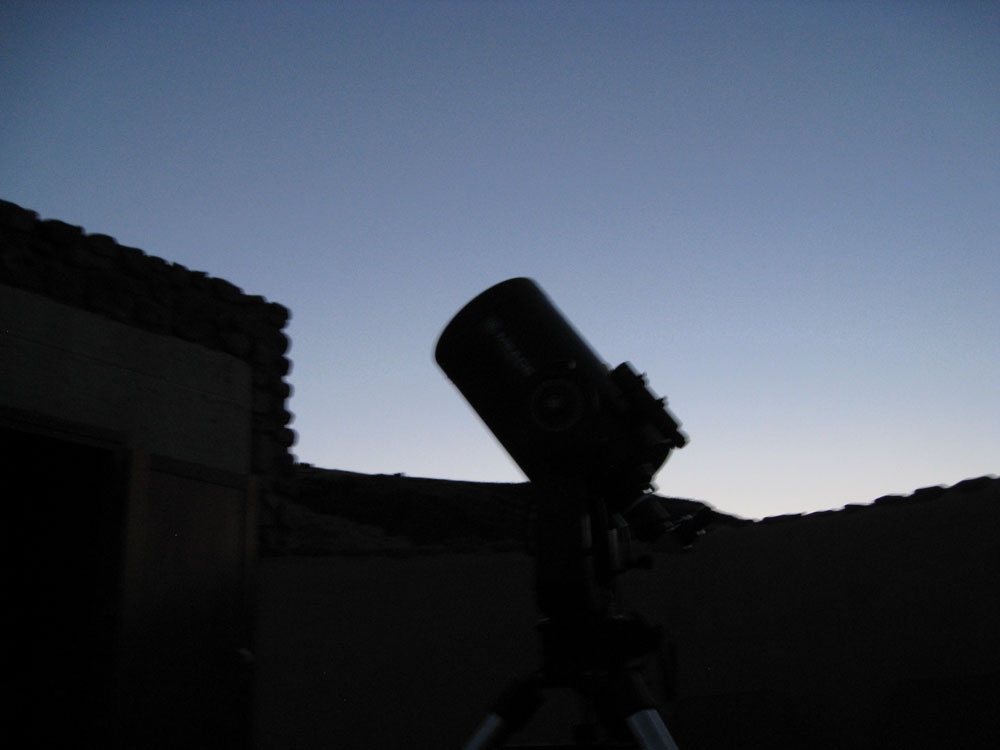If you have yet to read the introduction to the Sossusvlei Desert Lodge and the NamibRand Dark Sky Reserve, the equipment available and the observing report from night one, it can be found here.
The wakeup call came at 5:15am as promised and fortunately I had managed to grab an hour or two of sleep. At that time of the morning it is still very dark, and walking into the bathroom I was stunned by just how much of the night sky I could see through the window that looked out over the plains. The two Magellanic Clouds and Milky Way were clearly visible as was the Southern Cross which had disappeared near the start of the previous nights stargazing. So dark was it still, the only way I could tell where the horizon met the sky was that the Milky Way just vanished abruptly. My mind was already thinking about the night’s stargazing ahead, but first a trip to Sossusvlei and the world’s largest sand dunes awaited.
Sossusvlei is a salt and clay pan which is surrounded by beautiful, ever evolving pink to orange sand dunes, which are shaped and pushed towards the skies by competing and opposing winds that blow from the coast and inland Africa. The name “Sossusvlei” is a mix of Afrikaans and Nama. Vlei is the Afrikaans word for “marsh” while Sossus is Nama for “dead end.” The region owes its name to the fact that it is an endorheic basin, i.e. a basin without outflows for the ephemeral Tsauchab River. Ephemeral it may be, but over 2 million years it has managed to carve the Sesriem Canyon which is a kilometre long and up to 30 metres deep in places near the entrance to the Namib-Naukluft National Park.
An early morning start is advisable for this visit, as not only does a low sun create fantastic shadows which stand in stark relief to the towering sand dunes, but as you are likely to try and conquer one of the dunes on foot, it is preferable to try before it hits 40 degrees, as it did in the afternoons during our stay. If you are feeling particularly heroic, you can attempt “Big Daddy” as it is informally known. It is the highest dune in the immediate area at around 325m (though Dune 7 is the true daddy and highest sand dune in the world). However, we successfully ascended a dune next to the 4×4 parking and picnic area, which is more modest 80 metres high and not too steep. This dune is also a good choice as once you reach the summit, you can make your way (rapidly if you are not careful) down the side into Deadvlei.
Deadvlei, with its almost pure white salty floor is punctuated with blackened dead acacia trees and stands in stark contrast to the towering orange dunes that surround it. After enjoying the beautiful surroundings, we replaced those lost calories from the climb with a breakfast prepared by our guide before heading back to the Desert Lodge. That afternoon, I took the opportunity to nap for an hour to ensure I had the stamina for my first dusk-till -dawn stargazing session of this trip.
Night 2 – from Dusk-till-Dawn and a Comedic search for Comet ISON
To ensure that I spent more time observing and less time with my head buried in a copy of Sky & Telescope Pocket Sky Atlas looking for interesting objects to view, I spent some time in the late afternoon preparing a list of DSOs to view that night. List in hand, we enjoyed a lovely dinner on the veranda and were treated to wonderful sunset with a 1.7 day old moon joining Mercury and Saturn low in the sky with Venus shining brightly above them.
After enjoying some lovely, though slightly turbulent views of Saturn and a sharp terminator on the moon, I took a quick view of Mercury. Notoriously hard to see, this planet never wanders far from the Sun (even Nicolaus Copernicus, the father of the heliocentric model of the solar system is said to have sighed on this deathbed that he never saw Mercury – though that might be a myth), so I was not about to pass up this favourable elongation from the sun and relatively clear horizon. By 7pm, this celestial wanderer was a mere 10 degrees above the horizon and presenting a disc of only 6 arcseconds. However, the 67% illuminated phase could be made out in moments of steadier seeing. Happy that I had seen Mercury for only the seventh time through a telescope, we moved on.
Despite viewing many showpieces of the Scorpius and Sagittarius region of the sky the previous night, I could not resist another peek so we took in the OCs M6 and M7 again, before moving onto a number of globular clusters in the area. M4, M80, M62 in Scorpius and M19, just over the border in Ophiuchus, before taking in 5 more in Sagittarius, M69, M70, M75, M54 and M55. M19 certainly is far from being the most spectacular of the viewed GCs, but it is perhaps the most interesting. It is one of the most elongated globular clusters known and its elliptical shape is immediately obvious in the EP with a roughly 3’ x 4’ core and a halo that is perhaps 5’ x 7’, though our impression of this ellipse might not accurately reflect its true shape. The light emitted along its eastern side is being strongly absorbed by intervening gas and dust along our line of sight. When the cluster is viewed in the infrared, it shows no such flattening.
We next moved on to Corona Australis, the small Southern Crown that sits under the celestial teapot. Our intended targets were 3 globular clusters (NGC 6723, 6541 and 6496) and a very interesting complex of reflection nebulae with three separate NGC designations, 6729, 6727, and 6726. The whole complex was nicely framed by a 32mm plossl and its half degree field. This complex of reflection nebulae are located between two variable stars, R CrA and T CrA. To me, NGC 6729 looked almost comet like and NGC 6727 and 6726 surrounded a number of reasonably bright stars of 7 to 9th magnitude. Measurable changes in brightness can be detected in this group of reflection nebulae in as little as 24 hours and this variability is associated with R CrA.
After this extraordinary view of a reflection nebula, we decided to take a detour back to more familiar northern constellations and stopped by the Summer Triangle constellations (or Winter Triangle as they are known in the Southern Hemisphere) of Cygnus, Lyra, Sagitta and Vulpecula. Our intended targets were two rather well known planetary nebula, M27 and M57, and one supernova remnant. The Veil Nebula in Cygnus is the remnant of a supernova that exploded between five and eight thousand years ago, and has since expanded to cover an area approximately 3 degrees in diameter. As such, we had no chance of viewing the whole loop in a single view due to the 3 metre focal length of the LX200R and it was the second time I found myself longing for my APM 105 refractor. Armed with a 35mm Panoptic, the field of view extends to 3.4 degrees and would have nicely taken in the whole object. Despite that we had some very pleasing views of NGC 6960, the Witches Broom, as well as NGC 6992 and 6995.
It was at this point that both Doug and I commented on the extraordinary number of meteors we were both spotting. While the dark skies were no doubt increasing the number of faint meteors we saw, a good number were fairly bright with persistent tails. The Southern Taurids are active from around September 10th to November 20th and are known for being slow moving and showing a typical zenithal hourly rate of 5 per hour. Many examples spotted were slow moving and by about 1am we were seeing close to 20 an hour; most could be traced back to a point in Taurus so it would seem we were lucky to be graced by a short peak in activity.
Our next intended targets were to be found in Pegasus and Capricornus. Cadwell 30 (NGC 7331) was our first stop. A beautiful spiral galaxy inclined to our line of sight, located approximately 40 million light years distant, it has often been referred to as the Milky Way’s twin due to size and structure, though recent discoveries about the Milky Way do somewhat call that comparison into question. Interestingly, the bulge in this galaxy rotates in the opposite direction to the rest of the galactic disc which is in contrast to the behaviour seen in most spiral galaxies. Rather bizarrely, considering we were focused on NGC 7331, we did not make the short hop of a degree to take in one of the most famous compact galaxy groups in the night sky, Stephan’s Quintet. I had a stunning view of grouping in Namibia in 2011 and I am still surprised I did not revisit this glorious arrangement.
Next on the list were two globular clusters, M72 and M30, and one planetary nebula located in Capricornius and Aquarius. NGC 7009 is known as the Saturn Nebula due to its distinctive shape with “edge on rings” which gives the impression of the view of Saturn through a telescope which has been slightly defocused. The planetary nebula had a distinct yellow-green hue which is product of doubly ionised oxygen which is the result of ultraviolet irradiation of the gaseous surroundings by the hot blue dwarf at the centre. In my opinion the Saturn Nebula truly stands out among planetary nebulae with is distinctive colour and shape, combined with high surface brightness.
Never one to pass up a look at my absolute favourite deep sky object anywhere in the heavens, we swung over to the LMC and the Tarantula Nebula. However, the Tarantula was to be only a brief distraction from the other deep sky wonders found within the LMC. While from our perspective, the LMC appears as bright nebulous haze with absolute dimensions of approximately 10 degrees in diameter, it is sometimes easy to forget that the LMC is in fact another galaxy in orbit around the Milky Way some 160,000 light years away, stretching almost 14,000 light years across. Contained within is a cornucopia of nebulae, open clusters and globular clusters, many of which are well within reach of amateur size telescopes. As the below image (complete with annotations) from the European Southern Observatory shows, the LMC is packed with interesting DSOs just waiting to be observed.
We used a detailed star chart from Sky and Telescopes Pocket Sky Atlas which plots a number of the brighter LMC nebulae and clusters as our guide and began with three globular clusters, NGC 1786, 1978 and 1835. All 3 demonstrated the classic structure with small tight cores and fainter outer halo. While none of them will knock your socks off, to take a step back and realise you are viewing a globular cluster in another galaxy really is something rather special. There is a tremendous number of emission nebulae besides the Tarantula located in the LMC and some of them are surprisingly bright, especially considering the distances involved. For me the highlight was NGC 2074 and NGC 2077/80. All 3 emission nebulae were bright, showing a greenish hue but what was staggering was all three were contained in the same view with the 32mm plossl. This leads me to perhaps the most attractive quality of spending some real time observing the LMC. Due to the density of DSOs contained within this orbiting dwarf galaxy, almost every field takes in multiple interesting deep sky objects at once!
After spending more than 45 minutes on a DSO hunt around the LMC, we decided to go galaxy hunting in Sculptor, Fornax and Andromeda. Both Sculptor and Fornax were now very well placed near the zenith but we started with perhaps my favourite edge on spiral galaxy, NGC 891 (Caldwell 23) in Andromeda. A spiral galaxy which is tilted only 6 degrees from edge on, it is admittedly a tough object for visual observers as much of the light from the galaxy’s 100 billion plus stars is obscured by the very prominent dust lane that runs the length of the galaxy. However, under these fabulous dark skies, the central bulge was prominent as was the hazy extent of the outer reaches of the galaxy, clearly bisected by the extensive dark equatorial dust lane which is captured so spectacularly in long exposure photographs.
NGC 1097, a barred spiral in Fornax came next. Through the scope it showed the characteristic barred structured, thanks to its face on orientation and two fairly obvious spiral arms trailing away from the bar. NGC 1097 is also famous for having among the brightest optical “jets” emanating from the core of the galaxy. Originally interpreted as transient manifestations of the currently weakly active nucleus, more recent study has in fact revealed the jets are composed of stars and are thought to be the remains of cannibalised dwarf galaxy. Sadly these jets are only revealed by deep photographs.
Having finished the previous nights truncated stargazing session in Sculptor, we could not resist a quick revisit to NGC 55 as we were exploring more galaxies that the constellation has to offer. NGC 253 is the most spectacular and is known as the Silver Coin. Making it into the late Sir Patrick Moore’s Caldwell catalogue (C65), observation immediately revealed a high surface brightness core, with a long oval bulge and very mottled disc. Using the 20mm plossl, for 150x magnification, the long axis of the galaxy extended almost across the entire field. NGC 253 is known as a starburst galaxy and is currently undergoing a period of vigorous star formation, which has created several super star clusters, one of which contains 1.5 million solar masses and has an absolute magnitude of -15! Analysis of the galaxy suggests that it collided with a gas-rich dwarf around 200 million years ago which disturbed NGC 253’s disc, resulting in the starburst we currently see. After spending time observing some of the other Sculptor Group galaxies we moved on to the very familiar Northern Hemisphere winter constellations of Orion, Auriga and Gemini which were now very well placed in the North. I am not sure I will ever get used to them being in the North.
While the obvious M42 was a first target, and never fails to impress, it was nice to spot the trickier E and F components of the Trapezium cluster which is wrapped in the delicate swirls and twists of the nebula it illuminates. However, these dark skies were begging for an attempt at IC 434, the Horsehead nebula. Notoriously difficult to see visually, perhaps the most famous photographic dark nebula needs a very transparent sky to glimpse and benefits from the use of a Hydrogen Beta filter. Unfortunately, we did not have one of those to hand. Located just off the belt star Alnitak, a good test of whether an attempt at the Horsehead is even worthwhile is NGC 2024, the Flame Nebula. Alnitak actually illuminates the Flame so it is only a very short hop to the Horsehead. The Flame was fairly obvious, bisected with its dark lane which reminds me of the wick of a candle as the source of fuel for the flame itself. With the sky transparency playing ball and the first test passed, it was on to IC 434 itself. Sadly this required a little more observational effort. After both spending some time with the view, we agreed that we could just about make out the Horsehead that is so distinctive in photographs using averted vision, but perhaps it was averted imagination. It might not be the first time I have fallen victim to seeing what I know should be there.
After enjoying the view of a few open clusters in Auriga, we moved onto what would be the last DSO of a very productive nights stargazing. Hubble’s Variable Nebula in Monoceros, the Unicorn. NGC 2261 (C46) is a very interesting reflection nebula as it demonstrates irregular changes in shape and brightness over time scales as short as a few days to weeks. The timescales involved eliminate the possibility that the movement of material in the reflection nebula as the source of the changes, as the velocities required would be supernatural, as well as features reappearing with later observations. Instead, current thinking is the variability is the result of shadows being cast by dark filaments which spiral around the star like a double helix, on a very short distance scale of perhaps only 1 to 2 astronomical units, supplemented by shadows cast by slower moving, more distant filaments within the shell of gas around the star which is analogous to a lighthouse beam being obscured by rotating storm clouds of differing distances. Through the eyepiece, its shape is unmistakable; I would say it looks like the way a child might draw a comet. A small bright nucleus is surrounded by a diffuse coma and trailed by a short stubby fan shaped tail. The observation that it looks comet like was to prove to be apt for all the wrong reasons just a few minutes later.
A Comedic search for Comet ISON
Before leaving for Africa, I made a note of the Right Ascension and Declination of the comet we all hope will become a showstopper in late November / early December, Comet ISON. Expected to have a visual magnitude of between +10 and +11 while we stayed at the Desert Lodge, the dark skies should have presented us with an excellent opportunity for an early visual inspection of a comet that only crossed the orbit of Mars on October 1st. However, so wrapped up in observing DSOs, we had failed to notice that the sky in the East was beginning to show the first signs of dawn. Somewhat panicked that in a few minutes we would lose the opportunity to glimpse this transient visitor to the inner solar system, I manually slewed the telescope to Mars which was now above the hills directly behind the observatory as I knew the comet was located close by. While doing this we were also attempting to work out how to manually enter R.A and Dec into the Autostar controller.
Between the two of us, we have a collective 70+ years of observing experience but apparently that counts for nothing when blue is encroaching on dark and tiredness is beginning to set in. Having successfully input the coordinates, I hit GoTo expecting the scope to move no more than a degree or two, only to see it whizz off at maximum slew speed towards Gemini. Huh? Immediately I wondered if I was not remembering the correct location of ISON, which I had only just stated to Doug was located between Leo and Cancer. Had I confused it with the short period comet, 2P/Encke which is also currently in our skies? Running out of time as the sky rapidly turned blue, we peered through the eyepiece to be greeted by dark blue sky and a lovely little comet with a tight compact nucleus and little fanned tail. Initial excitement very quickly turned to confusion as I had by then double checked the location of ISON on my iPhone. What were we looking at? Had we not been so tired, it would have been obvious as that description is very much like a certain variable nebula we had only just viewed. But no, that was not the thought that went through our minds. Had we just discovered a new comet?! Stranger things have happened. Thomas Bopp did not even own a telescope and was just using the scope of a friend when he stumbled on what would become the best comet most of us have witnessed in our lifetimes, Hale-Bopp in 1995. Thoughts turn to the name. Will it be Hodgson –McCarty, or McCarty – Hodgson? Perhaps we had got a little ahead of ourselves. Having now vanished from view, the sky was now blue from horizon to horizon with only Jupiter and Sirius still visible.
We shut down the scope, covered it and retired to main lodge building for an early morning tea still buzzing and confused by what we had just seen. Should I be looking up the email address of the International Astronomical Union to report a new discovery? No was the very short answer. Pouring over star charts we sadly realised what had happened. For some reason the scope had ignored our manually input coordinates and had returned to the last object viewed, Hubble’s Variable Nebula. Had I not manually slewed the telescope to Mars, the scope would not have moved at all. We discovered the following night, that once the coordinates are entered, the enter button needs to be hit once more before pressing GoTo for the telescope to move to the desired coordinates. Realising that we had been rather silly and that astronomical fame would have to wait for another night, I retired to the villa for a few hours of well earned sleep understanding perhaps for the first time, why the French comet hunter Charles Messier created his famous catalogue.











Pingback: Glorious Dark Skies - Sossusvlei Desert Lodge in Namibia | Alpha Lyrae
Pingback: Third night observing in Africa’s 1st IDA Dark Sky Reserve | Alpha Lyrae